Welcome to this latest edition of the RedState Ukraine Update, or, more accurately, my Ukraine Update posted on RedState. Sorry about the lateness of the edition. The battle lines have remained the same since the last update, and there has been no political action as Congress is in recess. Probably the most interesting item to appear this week is the number of Russian cities challenged by an absence of heat in subzero temperatures (real temperature, not Celsius). The cause is the companies who make the repair parts doing more lucrative defense work and the blue-collar workforce being ravaged by Russia's conscription system. And I have some thoughts on the demise of Putin propagandist Gonzalo Lira that may conflict with those of Tucker Carlson, David Sacks, and an array of other Putin fans.
Here are some of my past updates. For all my Ukraine War coverage, click here.
Putin's War, Week 97. The Missile War Continues
Putin's War, Week 96. Blowback From a Sunk Ship as Russia Launches Largest Missile Attack of the War
Putin's War, Week 95. The Russian Air Force Takes a Beating as Disease Rips Through the Russian Army
Putin's War, Week 94. Putin Makes Shocker AnnouncementUSnd the War in Washington Goes Into High Gear
Putin's War, Week 93. General Winter Hits the Brakes, Offensive Postmortems and Funding Fights
Putin's War, Week 90. Grain Corridor Reopens and Russia Hints at Another Major Retreat
Putin's War, Week 88. TIME Magazine and the Offensive GEUs a Postmortem blindside Zelensky
Putin's War, Week 87. The Battlefield Shifts to Washington and Brussels
Politico-Strategic Level
Sweden To Station Troops in Latvia
A few days ago, my colleague Ward Clark posted on Swedish officials, including the Defense Minister, warning Swedes that war was possible in the near future. Along with that warning came the decision to station Swedish troops in Latvia.
Sweden plans to deploy 800 troops to Latvia early next year, reinforcing NATO’s presence in the region, as announced by Swedish Prime Minister Ulf Kristersson. The Swedish soldiers will be stationed along Latvia’s border to act as a deterrent against Russian forces, collaborating with a Canada-led battle group already stationed in Ādaži, which includes troops from ten other countries such as Albania, Italy, Poland, and Spain.
This follows a decision by Germany to station troops in Lithuania.
BACKGROUND:
Already? Sweden Soon to Join NATO: Defense Minister Issues War-Warning to Swedish People
Putin's War, Week 95. The Russian Air Force Takes a Beating as Disease Rips Through the Russian Army
Black Sea Mine Clearance
One of the side effects of the indiscipline within Russia's military is that some areas of the Black Sea are heavily mined, and there are a large number of drifting mines. The minefields were poorly described, which resulted in commercial ships hitting mines. My gut feeling is that this is a feature of the Russian mining effort, not a bug.
Wednesday, Turkey, Bulgaria, and Romania signed an agreement to begin clearing mines in the Black Sea. The operation will be under Turkish leadership.
Türkiye, Bulgaria and Romania sign Black Sea mine clearance dealhttps://t.co/cmiy0QOx9L
— Lloyd's List (@LloydsList) January 11, 2024
Heat and Gasoline Shortages Hit Russia
Even though Russia banned the export of gasoline and diesel in September, that hasn't prevented a nationwide gasoline shortage.
Funny how russia's economy is based on the sale of hydrocarbons but they're unable to even provide enough fuel for the citizens of Moscow. This is a line at one of the few gas stations with fuel today. pic.twitter.com/DZM6gRG7mD
— BroSINT 69™ (@osint_69) January 10, 2024
Heating is also systematically failing across Russia, but it is hitting cities like Moscow the hardest.
🥶 Russia: Over 20,000 residents in the Moscow suburb of Khimki are freezing in -26°C (-15°F) temperatures. Central heating has systemically failed in various apartment buildings. Residents put out a banner on their balcony with the text "FREEZING." pic.twitter.com/UeKuUyZJCy
— Igor Sushko (@igorsushko) January 5, 2024
Russia is sinking in chaos and shit ‼️💩🇷🇺
— PS01 (@PStyle0ne1) January 9, 2024
Another city is freezing in the Moscow region: in Dmitrov, people first lost heat, and then they lost power and their sewer system burst.
The heating apocalypse has reached Dmitrov:
First, the radiators in the houses cooled down, and… pic.twitter.com/SwPtALmtID
This is not some sort of a Western information operation. Russian milblogging group Rybar has momentarily turned its attention from covering the Russian invasion of Ukraine to tracking Russian cities and neighborhoods in Moscow that do not have heat.
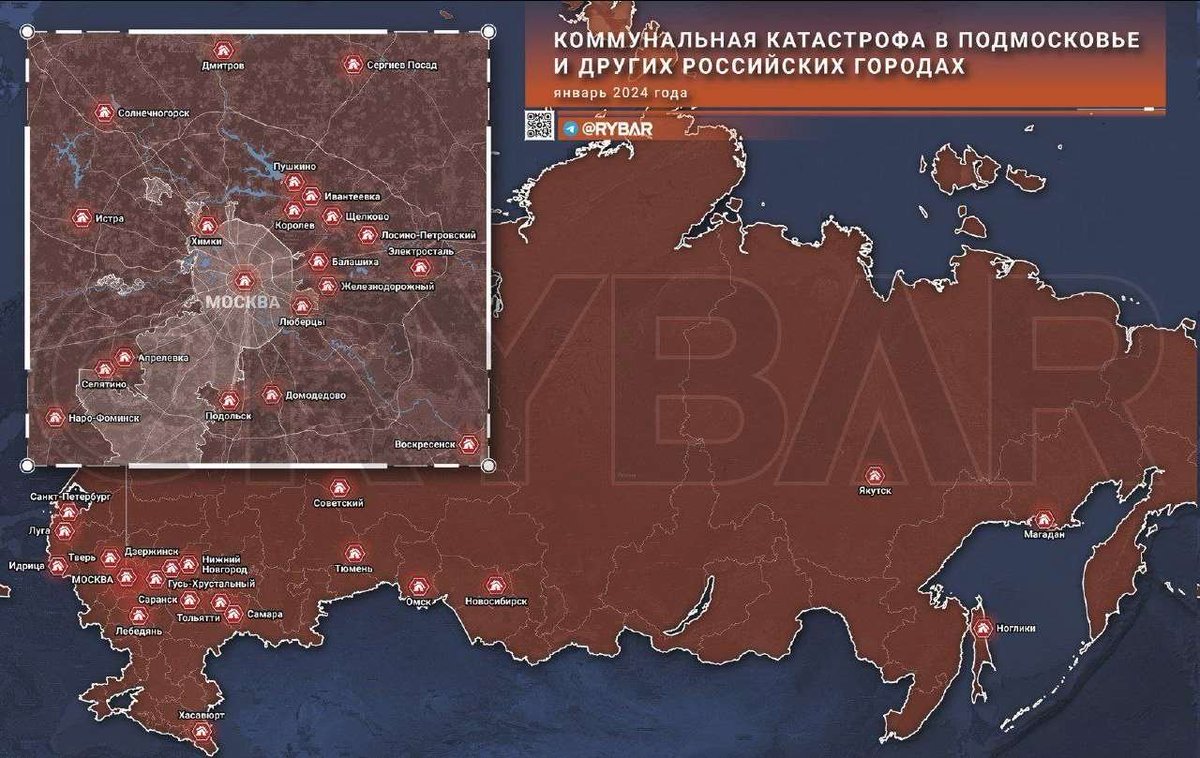
These failures are due primarily to the companies that used to service the central heating systems now working for the Russian war effort. As the war drags on, this will become worse. A Russian political commentator on Telegram says it is because the men who do the repairs are frequently turned over to the military by their employers.
The fact that the “hard worker” type, that is, that same worker or plumber who monitors the condition of utility pipes, is especially vulnerable to mobilization.
He works in absolutely transparent for the authorities and organizations subordinate to them places, he usually served in the military, and usually, such people are submitted to the military registration and enlistment office much more often than office employees or chauffeurs for the management. They don't feel sorry for them.
Read the whole thread. Eye-opening.
‼️The reasons for Russia freezing and flooding explained by a Russian political commentator on his TG channel:
— Natalka (@NatalkaKyiv) January 12, 2024
“Why the series of utility disasters?
The reasons can be named for a long time, but besides the banal wear and tear of the networks, there must be an explanation - why… pic.twitter.com/QHazGB6KrK
The second-order problem the Russian government has to address is the impact the war is having on society. The Russian Army that invaded Ukraine has ceased to exist. As noted above, the blue-collar guys who keep the country running bear the brunt of the war. The phrase "A rich man's war and a poor man's fight" is not unique to capitalist societies. The services available to returning and frequently disabled veterans are minimal to non-existent. There is no vocational rehabilitation or medical care. So, a significant number of Russian men will simply not contribute anything during their most productive years.
"Extreme losses—at least 315,000 killed or severely wounded in 22 months—have contributed to... a “ticking social time-bomb” in Russia, a country with just 143 million people." https://t.co/PS4pWEm64a
— Doctrine Man (@Doctrine_Man) January 2, 2024
BACKGROUND: US Intelligence Assessment Points to the Destruction of Russia's Pre-Ukraine Invasion Army
Across Russia, things are beginning to look like the 1980s again.
VIDEO from Moscow, Russia showing a line of cars waiting to fill up with petrol. Russians are "falling in line" (for eggs, food, fuel, heating ,etc) as the country reverts to the former Soviet Union. #Ukraine #Ukrainewar #UkraineRussiaWar️️ #Russia pic.twitter.com/DYDAIsjOSL
— raging545 - @[email protected] (@raging545) January 9, 2024
New Highway to Ukraine
This is just another example of how this war has forced integration into Western Europe at an accelerated pace. Once the war is ended, the commercial and political ties that have developed along this corridor will remain.
Romania builds new highway to Ukraine border
— NEXTA (@nexta_tv) January 7, 2024
It should create a new transportation corridor and provide Ukraine with access to Romanian ports, bypassing Poland, Hungary and Slovakia.
Romanian mass media report that the highway is being built in emergency mode: about 3,000… pic.twitter.com/WY2sRMQ0sk
Ukraine Leans Toward Mobilization
The Ukrainian Parliament is considering a general mobilization law. It's no accident that the most popular man in Ukraine has been pressed into service to support it.
Ukraine society has become polarized by mobilization. Almost no one is covering this in English speaking social media, but that’s topic # 1 in Ukraine. The implication are huge: Ukrainians will either unify even more or there will be polarization
— Tymofiy Mylovanov (@Mylovanov) January 6, 2024
This is what’s happening 1/ https://t.co/J8hSmyQYga
Ukrainian Support For War Remains High
An opinion poll in Ukraine indicates that support for the war and the government remain very high, Zelensky has a 66% approval rating. The most popular public figure is the Armed Forces commander-in-chief, General Valerii Zaluzhnyi, with an 88% approval rating. Public opinion is not as optimistic as it was in December 2022, coming off the extremely successful fall offensive that year. Still, there is no wavering on the necessity to continue the struggle.
Patriot Missile Kerfuffle
The New York Times had a very informative piece on Patriot operations in Ukraine a week ago. The Patriot has proven its worth in this war. It has proven it can defeat Russian hypersonic missiles, and it has smashed the Russian Air Force to the extent that Russian strike aircraft don't venture from the front lines.
BACKGROUND:
Ukraine Confirms a US-Supplied Patriot Air Defense System Shot Down a Russian Hypersonic Missile
Putin's War, Week 93. General Winter Hits the Brakes, Offensive Postmortems and Funding Fights
Putin's War, Week 95. The Russian Air Force Takes a Beating as Disease Rips Through the Russian Army
This paragraph appeared in the story:
But White House and Pentagon officials have warned that the United States will soon be unable to keep Ukraine’s Patriot batteries supplied with interceptor missiles, which can cost $2 million to $4 million apiece.
I don't know anything about the person or persons who write using this "John Ridge" account. But they are generally accurate if they do manage to give a damned good imitation of an imperious and insufferable t**t while doing it. Here, the account is absolutely on target on all points. I took that part of the story as an information operation by the White House and Pentagon to pressure Congress to act.
We can send older PAC-2s for a fraction of that value, potentially < $1M per missile depending on its age and how a PAC-2 depreciates in value over time.
— John Ridge 🇺🇸 🇺🇦 (@John_A_Ridge) January 7, 2024
David Sacks Has a Sad
Ordinarily, I wouldn't cover this kind of crap, but since Putin propagandist David Sacks suffered a spell of sadness and spread it over the internet, I will. This is how it started.
Gonzalo Lira’s last public statement is chilling. He knew that if arrested, he would die in a Ukrainian prison. He pleaded for public outcry to put pressure on the U.S. State Department to do what it ordinarily does for American citizens trapped in these circumstances. But the… pic.twitter.com/4UENSlAB7h
— David Sacks (@DavidSacks) January 13, 2024
John Donne told us, "Any man's death diminishes me," but Donne never met the pustulent sack of guts that was Gonzalo Lira.
Lira is a Chilean-American ex-pat YouTuber known as "Coach Red Pill" who has lived in Kharkiv, Ukraine, for several years. Immediately after the Russians invaded, he undertook the dubious evolutionary strategy of switching the focus of his videos from dating advice to pro-Russian commentary. Ukraine's security services arrested him on May 1, 2023, and because he was a huge threat to the Ukrainian war effort, he was immediately released on bail. Then he announced on Twitter that he was going to flee Ukraine, which violated his bail conditions.
Right now, I'm about to try to get out of Ukraine, and seek political asylum in Hungary.
— Gonzalo Lira (@GonzaloLira1968) July 31, 2023
Either I'll cross the border and make it to safety, or I'll be disappeared by the Kiev regime.
This is what's happened to me over the past three months.
1/25
He was arrested as he attempted to do just that. He's been in jail ever since. Because he pumped out Russian propaganda, he became a cause célèbre for Tucker Carlson and now David Sacks.
I don't know how he died, but I don't care. The arrogance of thinking that you can crank out enemy propaganda in a country at war and get a free pass because of some tenuous connection to the United States is just mindboggling. Maybe someone else will learn a valuable life lesson from Lira's stupidity. That anyone defends Lira speaks to an incredible level of stupidity, dishonesty, or allegiance to Russia, if not some of all. The Brits hanged William "Lord Haw Haw" Joyce for making propaganda broadcasts for the Nazis. The fact that LIra survived his first arrest and was released on bail is a testament to the restraint of the Ukrainian security services and court system.
You can bet if this assclown were alive today and in the US, he'd be waving his Palestinian flag and chanting, "From the River to the Sea."
If you want to feel sorry for him, that's your right. But this is a classic case of shooting yourself in the foot and then complaining because it hurts.
You can find more details on Lira here and here.
Operational Level
New Indian Ammunition Plant
There is the constant talk of "shell hunger," a shortage of artillery ammunition on both sides. The tankies and vatniks aren't going to want to hear it, but Ukraine will ultimately win this battle. Russia is relying on North Korean ammunition to tide them over until they can produce enough ammunition to sustain their combat operations. I don't think that is possible because no matter how much ammunition is produced, it can only get to the front after being shipped by one of two routes along a very limited number of rail lines. It must be stored within artillery range of the front lines and then moved to the front by a hodgepodge of military trucks, civilian trucks, vans, and automobiles.
At last count, fourteen countries were producing artillery ammunition for Ukraine. Germany and the US will approximately triple their pre-invasion production levels this month. Another major player has entered the scene: India. India becoming a supplier of artillery ammunition to Ukraine became public in early January and was covered in my last update. Now it has entered the market in a big way.
After handing over its first Indian made drones to the Navy, the Adani Group is going ahead with the inauguration of a mega ammunition plant in Kanpur, which it bills as the largest such integrated facility in south Asia.
...
"Looking at what's happening on the geo political stage on the Middle East and eastern Europe, demand has shot up in the past two years. We are talking about demands for 100s of millions of rounds which is coming from different parts of the world," Ashish Rajvanshi, chiwf wxwcutive officer of Adani Defence & Aerospace told ET.
The plant is likely to be expanded in the coming months, with a total of 500 acres set aside, and will produce large caliber ammunition, including 155 mm artillery shells that are in big demand across the world due to the ongoing Russia-Ukraine conflict. "The ammunition plant is now getting operationalised on the small caliber and very soon on the large caliber," Rajvanshi added.
BACKGROUND: Putin's War, Week 97. The Missile War Continues
New Armored Vehicle Repair Depot For Ukraine
The German defense company Flensburger Fahrzeugbau Gesellschaft (FFG) is breaking ground on a new repair depot to service German-made equipment.
[German Member of Parliament] Markus Faber emphasized the strategic importance of establishing domestic repair facilities, highlighting that it will significantly reduce repair time and eliminate the need for expensive and time-consuming transportation of equipment abroad. Furthermore, the initiative will provide an opportunity for the Ukrainian armed forces to train their mechanics on-site.
As I've posted before, tank, artillery, and infantry fighting vehicle factories are under construction in Ukraine, as well as several repair facilities. Russia still sends disabled vehicles to Russia for repair.
Non-Battle Attrition
This is an untold story on both sides. The constant use of aircraft, artillery, and armored vehicles greatly reduces their service life. It affects the Russian Army and Air Force much more than the Ukrainians. The Russians were never known for an efficient or even effective maintenance system. Where the Ukrainians are backstopped by a network of Western-operated repair depots staffed by contractors, and the frontline units go to some lengths to recover and evacuate damaged and inoperable equipment, the Russians don't. Russian vehicle recovery and evacuation efforts are, at best, sporadic.
Combat losses and the density of Ukrainian anti-aircraft systems have driven the gradual decrease in Russian airstrikes. But it has also been greatly aided by the wear and tear this war has imposed on the Russian Air Force.
A topic I have not heard many bring up: the service life of Russian military aviation being put through constant paces will result in the service-end of many an airframe, essentially resulting in uncounted "losses."
— Evergreen Intel (@vcdgf555) January 7, 2024
Piece by @mbohnerthttps://t.co/dvu340UFNg
Air Defense Battle
There was another round of attacks on multiple targets in Ukraine.on January 8.
BREAKING:
— Visegrád 24 (@visegrad24) January 8, 2024
Russia is firing everything it has at Ukraine right now.
Cruise missiles from bombers, sea-launched cruise missiles, ballistic missiles, hypersonic missiles, suicide drones & S-300 missiles against Kharkiv.
It's -10C in Ukraine.
They are going after the energy grid pic.twitter.com/cCEmKej8gR
This is the box score.
Ukrainian Air Defenses 🇺🇦 shot down only 18 of 51 missiles (35%) fired by Russia today
— Ukraine Battle Map (@ukraine_map) January 8, 2024
0/4 or (0%) of Kinzhal Missiles
18/24 or (75%) of X-101 Missiles
0/8 or (0%) of Kh-22 Missiles
0/6 or (0%) of Iskander-M Missiles
0/2 or (0%) of Kh-31P Missiles
8/8 or (100%) of Shahed Drones pic.twitter.com/Jr8aw61XaD
This is one point of view on why the interception rate is down.
Another round of dangerous strikes on Ukraine this morning.Russians used a greater % of ballistic missiles this time, they continue experimenting with how to evade and exhaust SAMs, and targeted areas had less SAM coverage. More missiles got through. https://t.co/rgkjrfKiFI
— Dara Massicot (@MassDara) January 8, 2024
I'm not sure I agree with all of it. I'd contend that the Russians have started selecting targets that are lightly defended, if defended at all. They focus primarily on targets very close to the front line that are not covered by the more sophisticated air defense systems. Any ballistic missile they fire outside the Kiev and Odesa areas will not be intercepted because of the limited number of Patriot systems. The Kh-101/X-101 cruise missiles and Shahed drones are easy pickings for most anti-aircraft systems; unless they are used on undefended targets, they aren't going to make it.
The saving grace is that attacks on this scale are rare. This is the third mass attack in the last month and also the smallest, being only a third of the size of the December 30 attack.

SOURCE: Russian Strikes on Ukrainian Targets
A for Effort and F for Judgment
The head of the Russian Airborne Forces mechanized forces was killed in action, helping tow a disabled armored personnel carrier. He'd delivered the tow cables and came under artillery fire while personally attaching them to the disabled track.
⚡️ Airborne Colonel Оспанов Арман Толегенович (Ospanov Arman Tolegenovich), head of the Airborne Forces Armoured Service, was eliminated in Ukraine on 6 January ’24. He allegedly got blown up by a land mine — so he was probably on the front line. Born in Soviet Kazakhstan. pic.twitter.com/htItOzrIy1
— KIU ✪ Russian Officers killed in Ukraine 🇨🇿🇺🇦 (@KilledInUkraine) January 7, 2024

This is an "A for Effort/F for Judgment" moment. If you are a colonel and you're putting towing cables on an armored vehicle at the front lines, you've failed. What else is going on in your command that requires the commander's attention? It might be necessary as a 4.2-inch mortar platoon leader to personally clear a hang-fire on one of the guns. A company commander might have to kick in a door. But you'd do that by way of setting an example. If you are a colonel and involved in vehicle recovery, either all the real problems have been solved, or you're overwhelmed and can't cope with the job.
Deep Battle and Interdiction
Battles are fought in several different ways. While the frontline fighting in Ukraine is pretty static at the moment, the Ukrainian Armed Forces are carrying out an active deep battle. As I've mentioned nearly weekly for two years, the key to the war in Ukraine is logistics. The Russians are dependent upon two supply corridors. One line coming out of Crimea depends on ships from Russia and limited rail traffic across the Kerch Strait Bridge. The other line comes from Rostov-on-Don.
These maps show why striking a railway bridge behind the lines can have an outsized impact on the battle. Supplies must be unloaded where the rail line ends and loaded onto trucks to move to the front. The Russian Army is designed to operate within 40km of a rail line.
💥 Advisor to the Mayor of Mariupol Andryushchenko announces the destruction of the railway bridge in the area of the village of Granitnoye.
— PS01 (@PStyle0ne1) January 7, 2024
Let me remind you that a couple of months ago the Russian Federation began construction of the Rostov-Mariupol railway line. To reduce… pic.twitter.com/ItJX9trD62
More localized black is existing railroads and orange is the new railroad under construction as of September. pic.twitter.com/oCatLj3Z3E
— Intelschizo (@Schizointel) November 2, 2023
Combat Operations
Digging In Continues
Two weeks ago, I posted on the Ukrainians building their own fortification belts to act as an economy of force operation in an area vulnerable to Russian attack.
BACKGROUND: Putin's War, Week 95. The Russian Air Force Takes a Beating as Disease Rips Through the Russian Army
The use of prefabricated shelters installed by earthmoving equipment is infinitely better than the knee-deep mud-filled slits in the ground prepared by the Russians.
The AFU is producing and installing prefabricated bunkers in trenches as safe refuge during artillery strikes.#WWI #OSINT #Counteroffensive #UkraineRussiaWar #UkraineWar #UkraineKrieg #Ukraine pic.twitter.com/quSNpSmA1q
— OSINT (Uri) 🇺🇸 🇨🇦 🇬🇧 🇺🇦 🇮🇱 (@UKikaski) January 7, 2024
Check out this thread for an excellent overview of Ukrainian and Russian fortifications; for a detailed map of existing fortifications and those under construction, visit this map.
« The Donbass Line🇺🇦 »
— Clément Molin (@clement_molin) January 10, 2024
Since 2014, 2022 and more recently winter 2023, Ukraine has been building a huge defensive system. The multilayered “Donbass Line” composed of many trench network is quite similar to Russian Surovikin system.
🧵THREAD on Ukrainian in depth defenses⬇️
1/25 pic.twitter.com/LUADmML74a
This fortification of a sector not currently under attack is necessary because of Russian troops currently stationed there.
Military: Russia keeps 19,000 troops on Ukraine’s northern border along Sumy and Chernihiv oblasts. https://t.co/oZGtJODw7r
— Euromaidan Press (@EuromaidanPress) January 8, 2024
Tactics, Techniques, and Procedures
Inside A DPICM Strike
One of the critical munitions in the Ukrainian arsenal is US-manufactured 155mm dual-purpose improved conventional munitions.
BACKGROUND: US Releases Cluster Munitions to Ukraine in Stopgap Effort to Aid Ukraine's Offensive
This video, taken by a Russian tank commander in the Kreminna area, shows what it is like to be caught by a DPICM strike.
💥STEEL RAIN 💥
— CJ (@CasualArtyFan) January 10, 2024
In the Kreminna Forest, a Russian armored column comes under fire from 155mm DPICM.
Despite what some say on Twitter, these rounds do still work in the trees:
Just ask these Russians. pic.twitter.com/wobVGHVt8T
M2 Bradley vs. T-90
This is a rather incredible video of a Ukrainian M2 Bradly infantry fighting vehicle duking it out at close range with a Russian T-90 main battle tank. It takes place in the Avdiivka Salient.
A Bradley enters stage left and, at the road junction, opens up on the T-90 that is stopped in the road. It exits stage right. At around 0:25, the tank is hit by an explosion of some type. At first, I thought it was DPICM, but on review, I'm sure that is incorrect. About the time the explosion hits another Brad appears at the bottom right. At 0:42, the Brad opens up on the T-90 with its chaingun. By 1:39, the tank is out of control. The tank commander is leaning on the gun control, causing the turret to spin, and the driver is trying to get them the hell out of Dodge.
Bradley IFV of the 47th Brigade of Ukraine engages in a battle with Russian T-90M, Avdiivka front. (Bradley is in foreground while T-90M is in the middle of the village). At the end of the video it’s visible that tank most likely received significant damage as the crew cannot… pic.twitter.com/uutTexfXf5
— Special Kherson Cat 🐈🇺🇦 (@bayraktar_1love) January 12, 2024
This is the end. The T-90 crashes into a grove of trees, and the crew, miraculously still alive, un-asses the vehicle.
The Ukrainian 47th Brigade released another video of the destruction of the Russian T-90M. It shows that the M2A2 Bradley shot that Russian vehicle almost point blank.
— (((Tendar))) (@Tendar) January 13, 2024
It further proves that the attached picture is indeed from the knocked out T-90M, though unlike assumed before… https://t.co/vRy6zjQSsl pic.twitter.com/rSumJH4Bnv
TOS-1A Hit by Drone
The TOS-1A is a fearsome MLRS that fires thermobaric and incendiary rounds.
Russian TOS-1A 220mm MLRS destroyed on the Avdiivka front. Presumably by FPV drone.https://t.co/ZZFtL3NXeV
— Special Kherson Cat 🐈🇺🇦 (@bayraktar_1love) January 9, 2024
P.S: Don't miss the fireworks at 0:41 https://t.co/n1Ra4RQq5G
Drone to the Rescue
This battle takes place near Synkivka in the Kupiansk area of operations.
It starts with a Russian assault team of about six soldiers trying to overrun a Ukrainian position defended by two men. Things begin to unravel when the Russian soldier attempting to flank the Ukrainians from the top of the screen decides he has urgent business elsewhere (see 0:24). There is an exchange of hand grenades between 0:30 and 0:44. The Russians go to ground. At 1:07, a Ukrainian grenade-dropping drone goes into action and eliminates the entire Russian assault team.
A battle between a Russian assault group and Ukrainian defenders for one of the houses on the northern outskirts of Synkivka (Kupiansk direction)
— GWAR69 🇩🇰🇺🇦 (@GwarWorin) January 10, 2024
You can see how the situation changed, not in favor of the russians when the Ukrainian drone-bomber arrived at 1 minute into video pic.twitter.com/fEkLCK5K95
Northern Front
This area had a lot of action, but there was little to show for it.
Kharkiv
There was no discernable change in the front lines.

Donbas
The Russians made incremental gains in two places, but the front line remained stable.
Bahkmut-Klishchiivka-Andriivka
There was a minor Russian advance near Bakhmut

Avdiivka
The situation in the Avdiivka Salient remained stable. The Russians made a small gain south of Marinka.

Southern Front
Zaporizhzhia
The front lines in this area remained unchanged.
Robotyne-Verbove- Novoprokopivka

Russian Attack Near Novopropivka Repelled
The Ukrainian army repelled the onslaught of the invaders on Novoprokopivka 💪🇺🇦 pic.twitter.com/LjMSPO2ULq
— Feher_Junior (@Feher_Junior) January 9, 2024
Kherson
The Russians have been pushing hard to reduce the Ukrainian bridgehead at Krynsky, but the bridgehead continues to hold.
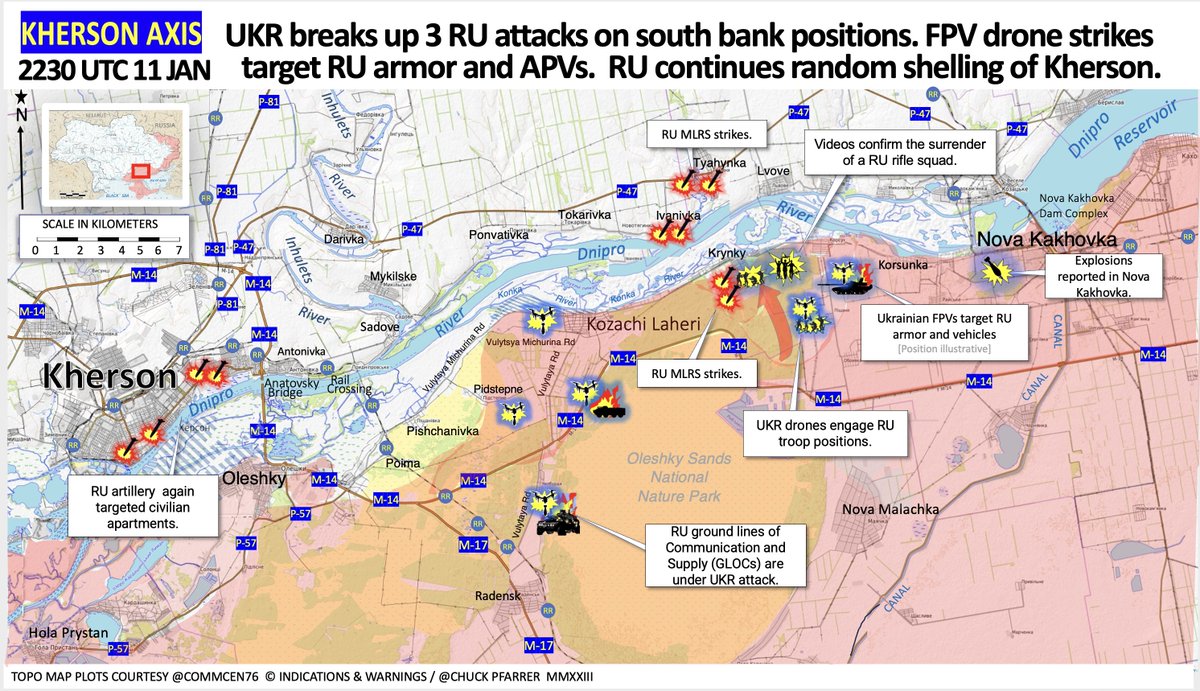
The Ukrainians have established air and electronic warfare dominance over this bridgehead. Their combination of drones and artillery has succeeded in halting all Russian attacks.
British Intel: Russian unable to resist Ukrainian FPV drones on Dnipro’s eastern bank in Kherson Oblast
— Euromaidan Press (@EuromaidanPress) January 12, 2024
🇷🇺lacks the electronic warfare capabilities in eastern Kherson to counter the🇺🇦drones, which destroyed up to 90% of🇷🇺military equipment in the area.https://t.co/HtOlv8WxpA
Epic destruction of a Russian tank with a Ukrainian FPV drone in Krynky.
— Status-6 (Military & Conflict News) (@Archer83Able) January 8, 2024
The hit resulted in an instant ammunition detonation and spectacular explosion. pic.twitter.com/9Bv08Grg0I
Rear Areas
Crimea
Military Base Hit
A Russian military base, reported to be an air defense headquarters, was hit. Russian Telegram sources reported that all missiles were shot down, but satellite imagery says otherwise.
Crimean Telegram channels reported a missile attack on the peninsula. Crimean "authorities" reported that all missiles have been shot down.
— Anton Gerashchenko (@Gerashchenko_en) January 4, 2024
Unofficial sources report that a military unit in Saky district of Crimea was hit by the attack. pic.twitter.com/CHEs6hqDCV
Ukrainian Army destroyed several ammunition depots and radar stations in Crimea on January 4.
— Clash Report (@clashreport) January 6, 2024
They were located at the airfield in Saki and near the village of Grishino. pic.twitter.com/IC1ccvbnav
More Deep Battle
The Russian Black Sea Fleet has largely abandoned Sevastopol as a base of operations. Ships are based at other Black Sea ports and sortied to Sevastopol as needed. That need is mainly to transport ammunition to warehouses in Crimea.
and just like that one of the main reasons for having crimea is lost. pic.twitter.com/7vDaxIzJyl
— david D. (@secretsqrl123) January 12, 2024
The list of lost and damaged Russian ships shows why Sevastopol is no longer a tenable home port.

Just like the strikes against the Russian rail line in Donbas are part of the deep battle, so is forcing the Russian Navy to evacuate a critical military facility without a direct invasion.
BACKGROUND: Massive Fireball Marks the End of A Russian Ship After Ukrainian Missile Attack
Russia
Attacks on Belgorod Continue
Belgorod in Russia. Uploaded 20 minutes ago. pic.twitter.com/I7KNlPaSPN
— JR2 (@JanR210) January 8, 2024
What's Next
The Foreign Policy SmartSet® consensus is that 2024 will be a year of waiting. Ukraine will be trying to gather its strength, and Russia will be interfering like mad in a half dozen critical elections in the US and Europe to try to run out the clock on Western interest in the war. Personally, I'm not sure I buy that. I think Ukraine is keenly aware that a little bit of political bad luck could strip them of the military parity they've managed to achieve. I don't think Russia's economy can take another year of this. When food staples are hard to find, and your apartment doesn't have heat, your focus on world conquest diminishes.
From looking at the videos, I think there is another couple of weeks before the ground is frozen solid. When that happens, I think the action will resume in earnest.
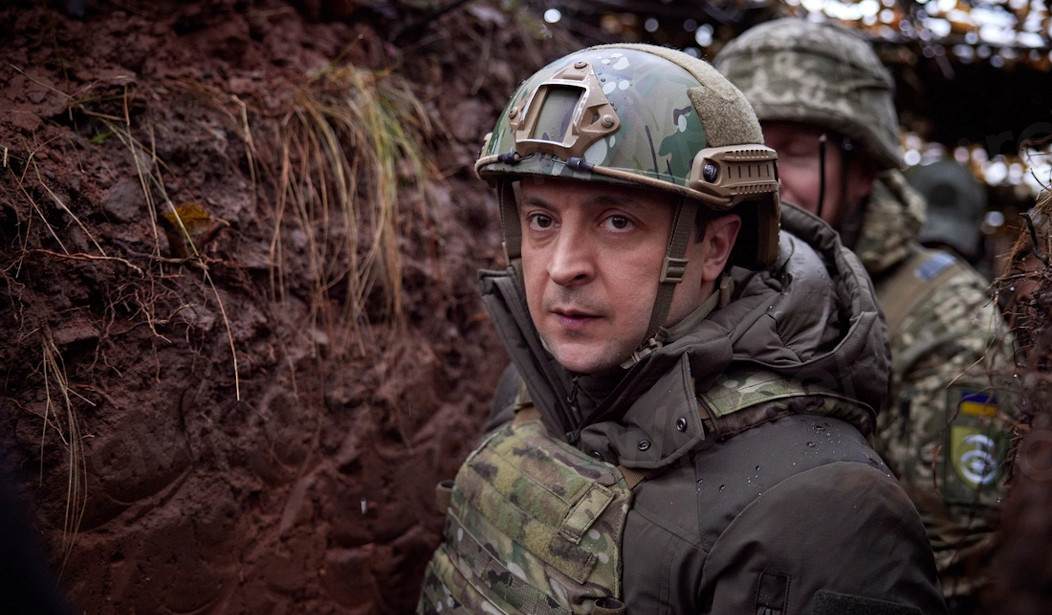





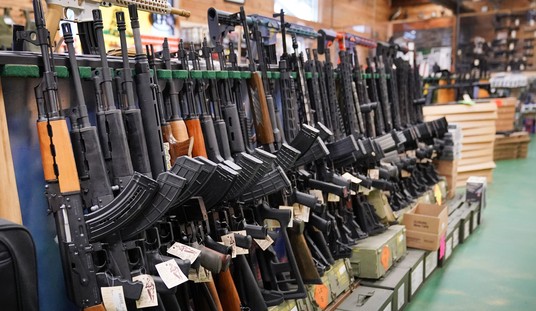

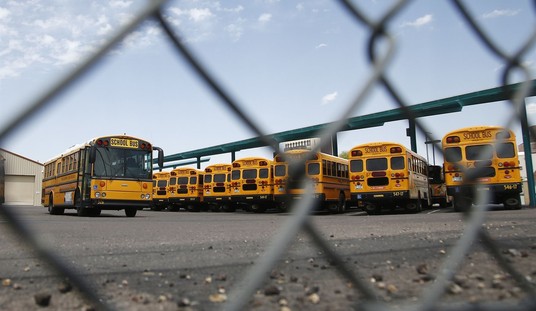




Join the conversation as a VIP Member